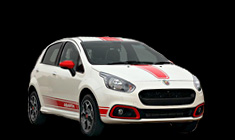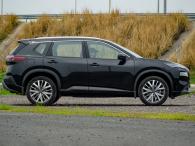News
50,000 km & 7 years with my grand i10: Overall experience & mileage
The Matiz and the Grand i10 are close to my heart. Both the cars accompanied me through significant stages of my life
BHPian TurboKat recently shared this with other enthusiasts.
I wish everyone a happy new year. Since 2022, I had been thinking about penning down an ownership review of our car. But hadn’t been able to write/type a single word due to my lack of creativity while playing with words as well as not having substantial knowledge on cars. However, after reading various long term ownership reviews, I finally decided to take the plunge. So, without further ado, I’ll start the writeup.
A brief background of the automobiles owned by my dad
My dad’s first vehicle was a 1986 Bajaj Super, bought from his older brother in 1988. He bought it right after earning the first profit from his newly established business and continued to use it till 2008. My parents got married in 1997. Initially they used the scooter for commutes as well as for occasional long-distance trips to their respective hometowns. Gradually, the need for a car arose.
Back in the late 90s, the Maruti 800 was selling like hotcakes and it was the default choice for the first-time car buyer. Dad was more inclined towards the Zen. He went to the Maruti showroom, enquired about the prices of the LX and VX variants and brought a quotation of both the variants to discuss with his younger cousins. Santro was not in the list as it was considered ugly by my mom. My uncles (dad’s younger cousins) used to keep track of the latest automotive news and were regular subscribers of magazines like Auto India. They suggested him to choose the Matiz instead of the Zen as it was more spacious and the F8C engine was a decent performer.
Dad went to the Daewoo showroom with one of his cousins on 16th November, 1999. The manager of the showroom was a relative of one of his customers. He informed dad about the prices of all the four variants (SS, SD, SE, SP) and the waiting periods. The showroom had three cars on display, a Mineral Red Matiz SS, a green Cielo and a Twinkle Beige Matiz SD. All the cars were booked. However, the manager had implicitly implied that the allotment of one of the Matizes could be changed by showing a later date of arrival to a customer. All dad had to do was to pay extra 10000 rupees to the dealership. Dad needed a car as soon as possible. So, he readily agreed to pay the extra amount. Next came the variant. The SD variant was a no brainer as it had air conditioning, left ORVM and a radio cassette head unit (AKF-4015) with two speakers right from the factory. The car was delivered on 17th November, 1999. With the exit of Daewoo Motors India Limited from the Indian soil in 2002, a lot of people sold their cars at meagre prices. Our car had covered 1 lakh kms. till then. Dad decided to hoard some parts from a known source (closing Daewoo dealer in Delhi) and retain the car.
Reason why we decided to buy a new car
Fast forward to 2015, the Matiz had served us through thick and thin and had covered 3 lakh kms. without a single engine rebuild. The Daewoo ASC had shut up shop in 2012. Since then, it was maintained by mechanics at FNGs. After shifting to FNGs, the car started showing signs of deterioration. In 2015, the engine was overhauled and radiator was replaced as the older one had started leaking at certain places. After the engine rebuild, the car had covered 25 thousand kms. On one rainy evening (16th April, 2016, to be precise), mom, dad, and I were returning from the marriage ceremony of a relative, hosted at their hometown (300 kms. away). It was around 9 pm when we reached Guwahati. Suddenly, clouds of white smoke started spewing out of the exhaust pipe. The car started to idle roughly and jerk violently during acceleration. Somehow, we managed to reach home and park the car in the garage. All of us were exhausted after the long trip. Dad decided to take the car to the FNG the next morning. Next morning, the car refused to start and even after starting for a brief period, it used to turn off. The mechanic was called home to diagnose the problem. He gave an estimate of 50,000 Rupees for the repairs. (I don’t know much in detail about what happened with the car as I was a 13 year old kid with minimal access to the internet, unlike some of the current BHPians who are in their early teens and are pretty knowledgeable about cars.) It was decided that instead of getting the car repaired, we would be buying a new car. Keeping that in mind, we started scouting for a new car.
Cars initially considered
Maruti Suzuki Swift ZXI
- Likes: It’s a Maruti = Excellent ASS + Easy availability of parts, as the K12M engine was shared with other cars + Best resale value
- Dislikes: Boot was small for my parents’ liking. Moreover, there were 5 Swifts in the extended family (two VDIs, two VXIs and one ZXI). They didn't want to buy a car which was owned by almost all the relatives.
Hyundai Grand i10 Asta Option 1.2
- Likes: It's a decent product from Hyundai, many owners had reported niggle free ownership experiences, sorted suspension, which wasn’t wobbly like the suspension setup found in the previous Hyundais, excellent fit and finish, sufficient boot space, good overall performance of the 1.2 Kappa engine.
- Dislikes: The fixed front head rests, but it wasn't a problem for my dad as he is 5'7".
Hyundai Elite i20 Sportz 1.2
- Likes: It was getting more goodies than the Grand i10 like reverse camera, an auto-dimming rear-view mirror, automatic climate control.
- Dislikes: As the kerb weight was more than the Grand i10, it felt sluggish.
Maruti Suzuki Baleno Zeta 1.2
- Likes: Same as Swift + fresh product in the market
- Dislikes: Waiting period of 6 months. We needed a car as soon as possible.
Ford Figo 1.2
- Likes: Better handling than the Marutis and Hyundais + good looks
- Dislikes: The 1.2 engine. Dad didn’t find its performance adequate.
The 1.5 TDCI was a gem of an engine. We could’ve gone for the base variant, but it was vetoed by mom and our monthly commute was below 1000 kms. So, buying a diesel car didn't make sense.
Wild card entry
Fiat Abarth Punto
- Likes: Well, I think there are a lot of threads that explain how special an Abarth Punto is.
- Dislikes: Fiat ASS was a gamble in North East India. We had heard a lot of horror stories from various people who bought Fiat cars.
The Abarth Punto was a 2015 car, owned by one of dad’s business contacts. They were selling the car as it wasn’t fuel efficient. Dad took the car for a spin and came back grinning like a maniac. He had finalized the car, paid a token amount to the seller and informed mom that he would be buying the car. Mom strictly laid out the condition that our next car would be of a brand which had a certain future in India, a well laid out network of service centres and easy availability of parts. So, the Abarth was cancelled. The gentleman was kind enough to return the token amount.
Ultimately, there were two contenders, the Grand i10 and the i20. The Grand i10 was chosen as it felt peppier than the i20, was comparatively cheaper and had the good-looking diamond cut alloy wheels. The Stardust shade was liked by everyone in the family. So it was finalized that we would be buying the top of the line variant in the Stardust shade.
The car was booked at a sub dealer of Oja Hyundai on 16th September, 2016 instead of the main dealer, as it was only 2kms. away from our home. We were promised a fresh car by the SA, and true to his word, we received a car which was manufactured on 28th September, 2016(decoded by a VIN checker). The car arrived at the stockyard on 5th October, 2016. All the formalities for the car loan were completed by 6th October. PDI was also completed on the same day and we brought the car home on 7th October, 2016.
The Matiz was sold to Hyundai H Promise. They offered Rs. 30,000 for the car, which was much better than the meagre amount offered by Maruti True Value.
- On-road Price = Rs. 6,71,000
- Festive Discounts = Rs. 20,000
- Old Vehicle’s Price = Rs. 30,000
- Final Price = Rs. 6,21,000
- Freebies offered = MOBIS seat covers, rubber floor mats, ambi pur perfume, mudflaps and an idol of lord Ganesh.
Dad decided not to opt for the insurance package offered by the dealer (Bharati AXA) and got it from Bajaj Allianz at a cheaper price.
It is a well-established statement that unlike the 90s kids, the 2000s kids don’t feel much excitement when a new car comes home. However, it was not true in my case. My half-yearly exams had ended on 5th October. I wanted dad to bring the car home on 5th itself. Mom said that the loan disbursement was not yet done and we needed to wait till the next day. I waited impatiently and kept praying for 7th October to arrive soon. The formalities were completed on 6th October. But dad didn’t want to take delivery of the car in the evening. On 7th, we arrived at the showroom in the afternoon. As the formalities were complete, we didn’t need to wait for long and took the car to a nearby temple for the pooja.
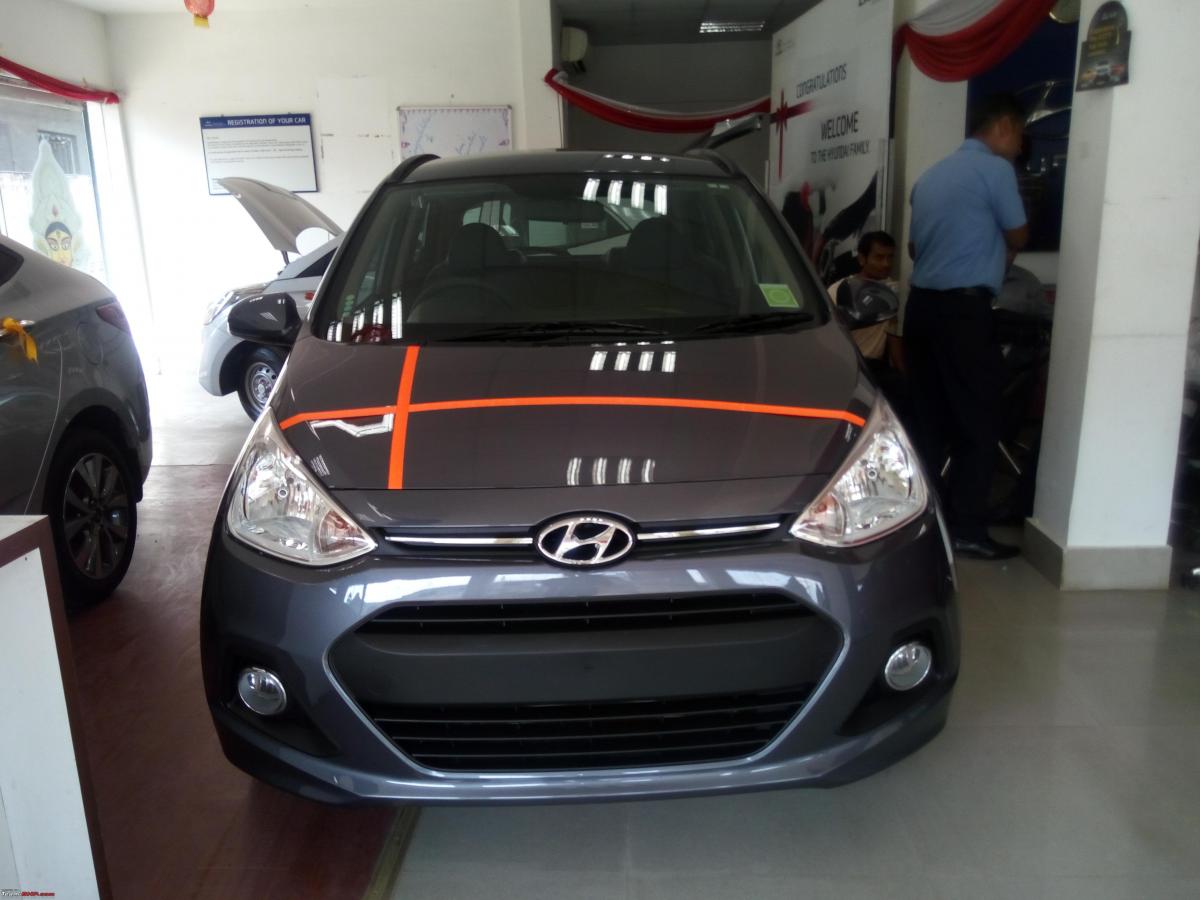
Pic clicked on the day the car was delivered.

Me and dad checking the new car, and a cleaner spraying Colin on the windshield.
I wanted to choose a name for the new car. One day, I was watching the Cars movie with a friend at his place. The Rust-eze brothers appeared on the screen and started cracking jokes. I liked those characters. One of the Rust-eze brothers was named Dusty. Moreover, the car's paint shade was nomenclatured as Stardust. Adding 1 and 1, it was child's play to decipher how the car received it's name. I was quite proud of myself that I had chosen a unique name for the car. Little did I know it was a fairly common name, as I later found out the nicknames of DBHPian Dr. AD's rides.
The official review of the Grand i10 is so detailed that I don’t think I can add anything much. So, I’ll just share the overall ownership experience in this post.
Initial days after buying and dad’s observations:
The Grand i10 was a significant upgrade from the Matiz, which had no power steering, no power windows, no ABS. During the initial days, dad was taking things slow and was gradually getting used to driving a car equipped with an EPS and ABS. Earlier, he had driven cars with power steering, but those had hydraulic units. He found the initial bite of the brakes to be excessive, but later got used to it. ABS proved to be very useful during situations of hard braking. Refinement of the 1.2 Kappa2 engine was miles ahead of the F8C engine of the Matiz. The F8C engine, being a three-cylinder unit used to vibrate more. In the Kappa, one wouldn’t even know if the engine was running. The engine was so silent that I remember him pressing the start/stop button to turn it on when it was running. Luckily, there’s a prevention mechanism to save the starter motor. This turns the engine off if one presses the button while the engine is running and the clutch is depressed.
The car hadn’t seen the highways for the first two months. Entire commute was within the city. The first service/ inspection was done on 7th November, 2016. Everything was fine and one of the ASC mechanics topped up the washer fluid. The first long distance run was to my mother’s hometown (140 kms. away). Odometer had crossed the 1000 kms. mark during that trip.
Some words to give an overall idea of the vehicle:
The heart of the car/ engine:
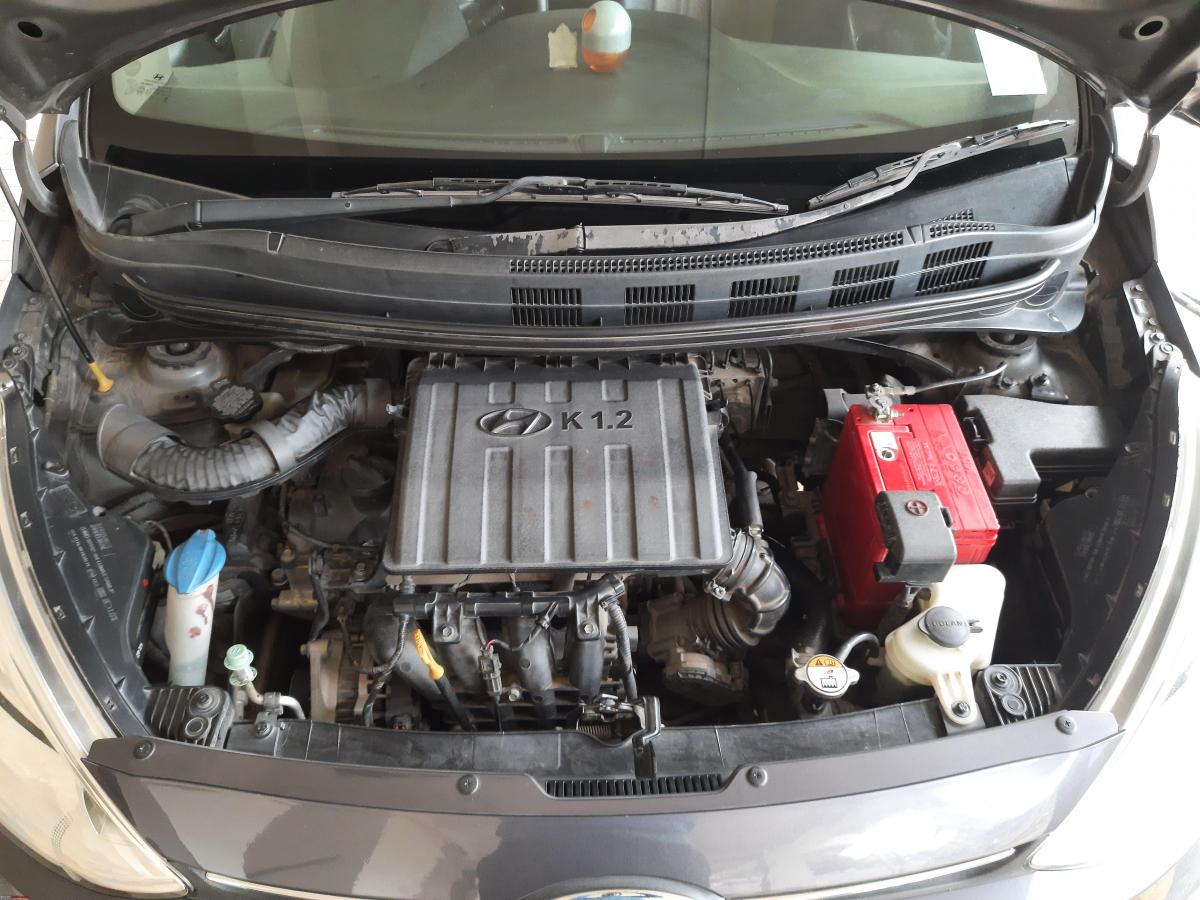
The engine of the Grand i10, having a displacement of 1197cc, is a gem in its own right. It is one of those engines which can keep chugging along without throwing tantrums, if routine maintenance is provided. The engine, being a 4-cylinder unit does an excellent job in controlling the NVH levels. In low RPMs, there is almost no noise from the engine. Refinement levels are so good that Hyundai didn’t bother to provide insulating material on the bonnet or the firewall. However, as revs increase, some noise starts to enter in the cabin. This is evident especially while redlining the car in 1st and 2nd gears. The 1.2 Kappa2 is a revv-happy unit and idles at the 800rpm mark. Revv limiter is at 6500 rpm. Driving in the city is stressfree and frequent downshifts are not needed. It is easy to potter at 40 kmph on 4th gear without any clutch input. On the highways, performance is adequate. One can effortlessly keep cruising at 120 kmph throughout the day without the engine feeling strained. It can do very well while keeping up with engines twice its displacement. But not without its limitations. With AC switched on and 5 passengers on board, it takes quite some time to build up speeds. It won’t satisfy people who are after outright acceleration and performance. 0-100 kmph takes around 13 seconds.
The 1.2 Kappa is not a sprinter, but a cruiser. It was designed to offer easy driveability in the city and provide good fuel economy. But outright performance is not its forte. This is a car which is neither slow nor crazy fast.
Transmission:

Pic borrowed from Team BHP's official review of the Grand i10.
The Grand i10 petrol used to come with a 5 speed manual gearbox and a 4 speed torque converter automatic gearbox. Our car has the 5 speed manual gearbox. The shifts are smooth, gears are easy to slot and don’t require effort. Some owners have reported that engaging reverse is sometimes tricky. We faced the issue initially. However, there’s a trick. The trick is one needs to press the clutch pedal fully and engage reverse with a little bit of force. After following it, we haven’t encountered that issue again.
Ride and handling:
This is an area where the Grand i10 gets full marks when compared to the older Hyundais. It’s suspension setup does an excellent job in absorbing the undulations and maintaining composure. It makes sure that small bumps and potholes are not felt by the passengers in the cabin. Straight line stability is great and it handles the curves decently, but not as good as the other options which we had considered, like the Figo or the Punto. Handling is predictable and the car doesn’t bounce like the older Hyundais. However, the soft suspension setup bottoms out with full load.
Fuel Economy:
Fuel economy was one of the requirements when we bought our car. We needed a car which had decent fuel economy, around 13-15 kmpl within the city and 16-18 kmpl on the highways. The Grand i10 perfectly suited our needs. With dad’s sedate style of driving and gearshifts at lower rpms, he gets 14-15 kmpl within the city and 18-19 kmpl on the highways (by tank-to-tank method). I, on the other hand, generally obtain figures like 11 kmpl inside the city and 16 kmpl on the highways.
Interiors:
The interiors of the Grand i10 have excellent fit and finish. The dash board is well laid out with a mixture of beige and black, like the doorpads. There are plenty of storage spaces in the car. All the doorpads have slots which can easily carry one 1 litre bottle. The factory fitted leather wrap steering is nice to hold, but has worn out with usage. The gear knob is also wrapped in leather and looks great with the chrome letters and glass finish, unlike the ones in the lower variants. Nobody can identify any signs of cost cutting in a single glance of the interior. However, if one has a keen eye, they will be able to notice cost cutting in form of the auto down feature of the driver window. Hyundai didn’t provide the feature of auto up for that window. I personally feel that the cabin doesn’t feel outdated even after a decade of the launch of the Grand i10. Just plonking in a touchscreen head unit will make it look updated.

The well laid out dashboard.
The car even has a rear AC vent. It isn’t much effective like the vents on the dashboard, but still does its job. Moreover, there are two 12V sockets, one below the climate control panel and one below the rear AC vent.
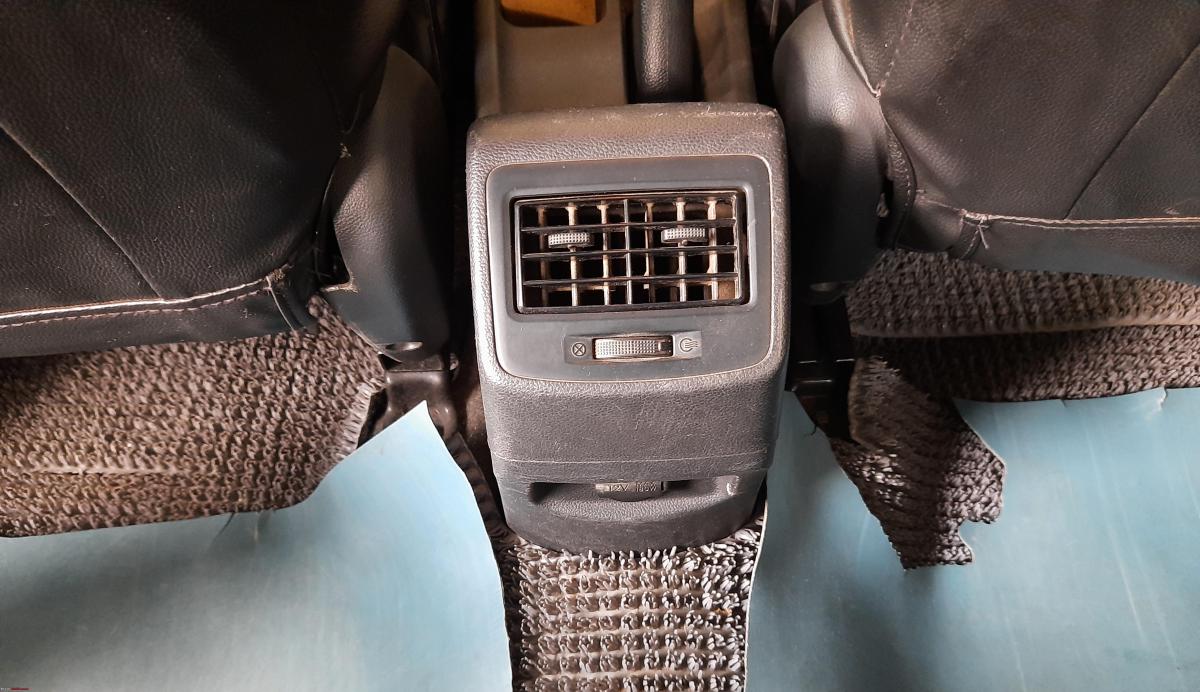
The rear AC vent.
The seats are well contoured and the passengers do not feel tired even after long journeys. My mom thinks the front seats are the most comfortable ones among all the cars she has ridden till now.
The stock head unit is outdated by todays standards. It has options of FM, AM, USB, Bluetooth playback and 1GB memory to store songs. The unit can play MP3, WMA and AAC files, but not FLAC. I discovered this recently. The 4-speaker setup is decent, but the rear speakers feel weaker than the front speakers. Till now, there are no plans of upgrading the speakers.
The instrument console houses the speedometer, tachometer, fuel and temperature gauges and an MID. The MID contains two trip metres, engine running time, average speed. The latter options are of no use for us. We only use the trip metres. All the lights of the interior except the cabin light have blue backlighting.

The instrument cluster.

A pic of the dashboard with blue backlighting.
Exterior
The Grand i10 carries forward the company’s fluidic design language. But it is toned down than the other cars from their stable. Our car, being a pre facelift model has a hexagonal front grille with horizontal slats and foglamp insets without provision for DRLs.

The rear bumper doesn’t have a black plastic insert, has smaller reflectors than the facelift and 4 reverse parking sensors.

The variant and engine badges.
The 14 inch 8 spoke diamond cut alloy wheels look great and are easy to clean

The car has useful features like keyless entry on both doors.

Continue reading BHPian TurboKat's review of his Grand i10 for more insights and information.









.jpeg)

_7.jpg)




